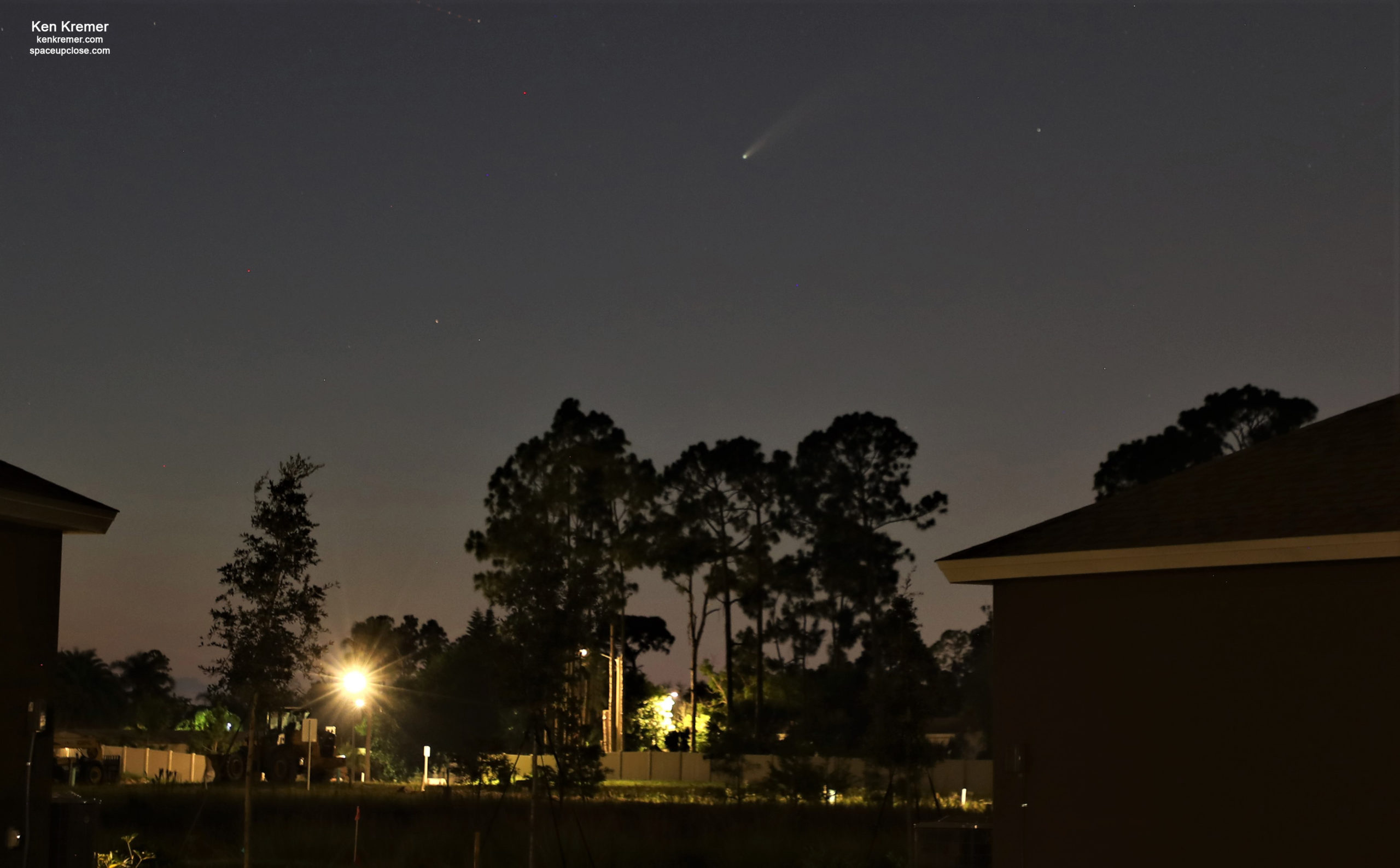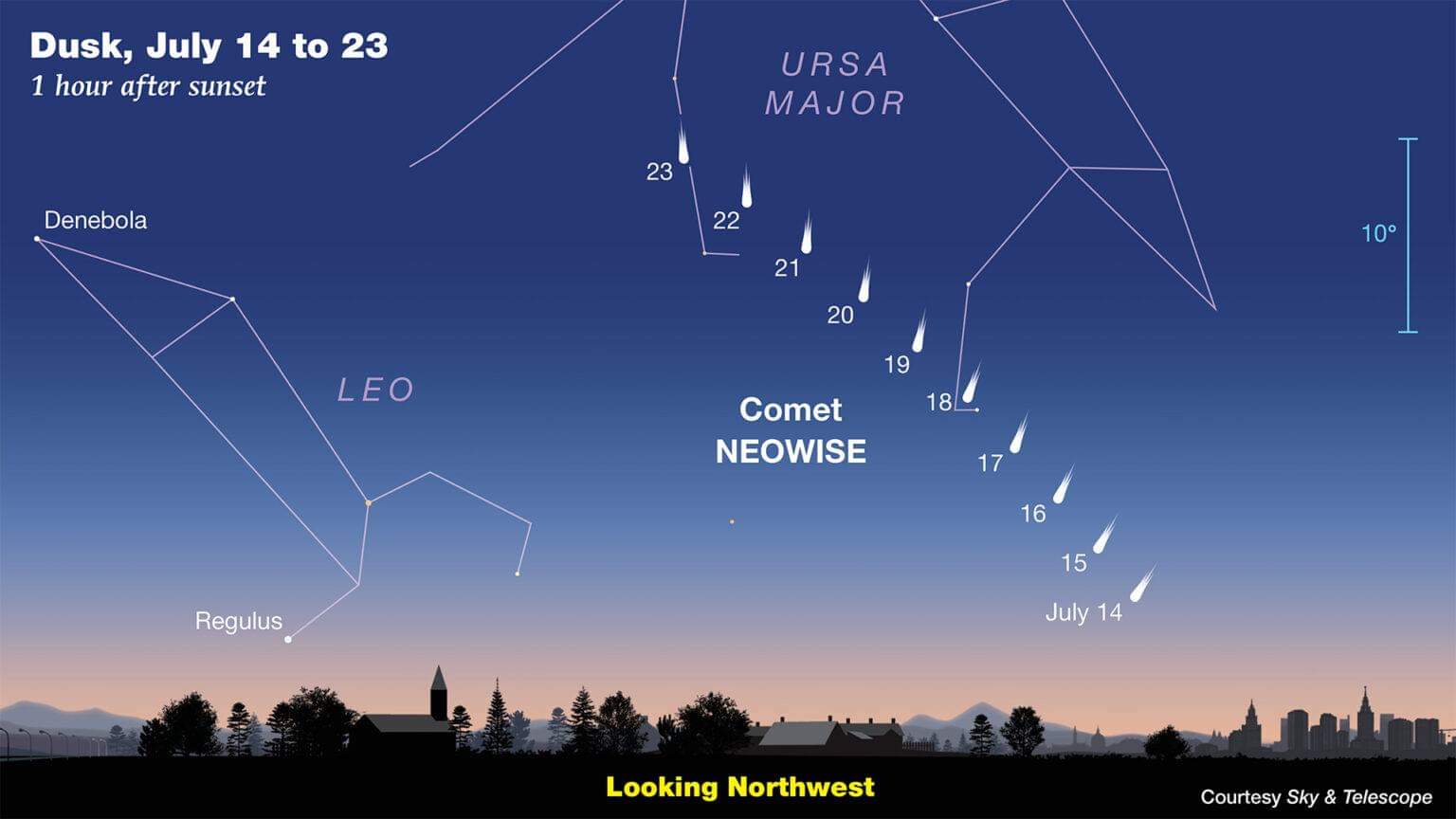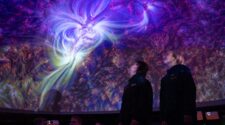
Recently discovered Comet NEOWISE (C/2020 F3) is now putting on a dazzling display in the early evening for skywatchers in the Northern Hemisphere and it is right at prime time, roughly 45 minutes or so after sunset, and showing off a spectacular tail to boot – as it passes through the inner solar system, weather permitting of course.
So you should really be sure to try and catch a glimpse of the best comet viewing in about two decades before it disappears into deep space – basically almost forever for us – for the next 6800 years!
In fact, it is one of the brightest comets visible in the northern hemisphere since Comet Hale–Bopp in 1997.
Until just a few days ago Comet NEOWISE was only observable in the early morning hour just before sunrise – and was hard to catch between the morning haze around 45 minutes before sunrise at around 515 to 545 a.m. ET.
That’s all just changed!
So between now and the end of this month will be your best chance to see it in the evening skies when its most convenient for most of the population – and rising increasingly higher each day in the evening skies above the northwestern horizon.
Personally I’ve seen it this past week before sunrise last week on July 11 looking to the northeast and after sunset last night July 16 looking to the northwest – from my base in the Florida Space Coast.
Currently it is approximately magnitude 2.
https://x.com/ken_kremer/status/1283955728357691392
Dark sky locations are of course best for comet viewing with the naked eye and otherwise.
But I located it in the town of Titusville with the help of binoculars and a camera.
I observed Comet NEOWISE last night Thursday, July 16 starting about 45 minutes after sunset starting about 20 degrees above the horizon – from about 9 to 10:15 p.m. ET from my house as it declined to the horizon and disappeared behind trees and houses.
And last week I observed and photographed Comet NEOWISE rising over the Max Brewer Bridge in Titusville – below the star Capella in the constellation Auriga.

But be aware that the best way to find NEOWISE is with binoculars and a camera standing stationary on a tripod taking exposures lasting a few seconds.
Although I’ve seen NEOWISE with binoculars I’ve not yet seen NEOWISE with the naked eye – although that should change soon as it rises in the sky during the month of July.
Comet NEOWISE was only just discovered less than four months ago on March 27, 2020, by NASA’s Near-Earth Object Wide-field Infrared Survey Explorer (NEOWISE) space telescope mission.
The comet has already passed the sun making its closest approach (perihelion) on July 3 at a distance of 0.29 AU (43 million km; 27 million mi). That passage increases the comet’s orbital period from about 4500 years to about 6800 years.
Now it is traveling further away while it gets closest to Earth on and until July 23 at 01:14 GMT at a distance of 0.69 AU (103 million km; 64 million mi).
Luckily Comet NEOWISE is actually fairly easy to find at the moment since its located below the Big Dipper asterism the constellation of Ursa Major – thus very easily recognized by virtually everyone.

NASA has released a new graphic as well that shows its location for the remainder of July.
Now, here are some tips from NASA on how to observe Comet NEOWISE:
For those hoping to catch a glimpse of Comet NEOWISE before it’s gone, there are several observing opportunities over the coming days when it will become increasingly visible shortly after sunset in the northwest sky. If you’re looking at the sky without the help of observation tools, Comet NEOWISE will likely look like a fuzzy star with a bit of a tail, so using binoculars or a small telescope is recommended to get the best views of this object.
For those hoping to see Comet Neowise for themselves, here’s what to do:
- Find a spot away from city lights with an unobstructed view of the sky
- Just after sunset, look below the Big Dipper in the northwest sky
- If you have them, bring binoculars or a small telescope to get the best views of this dazzling display
Each night, the comet will continue rising increasingly higher above the northwestern horizon as illustrated in the graphic below:

Want to learn more about Comet NEOWISE? Take a look at some of these resources:
Read these skywatching Tips from NASA: https://solarsystem.nasa.gov/whats-up-skywatching-tips-from-nasa/
Learn these tips and trick on how to photograph comets and meteor showers: https://solarsystem.nasa.gov/news/510/how-to-photograph-a-meteor-shower/
Take a look at these images of Comet NEOWISE captured by NASA missions:
- Parker Solar Probe: /feature/goddard/2020/nasa-s-parker-solar-probe-spies-newly-discovered-comet-neowise
- International Space Station: /image-feature/comet-neowise-from-the-international-space-station and /image-feature/comet-neowise
- ESA and NASA’s Solar and Heliospheric Observatory: https://svs.gsfc.nasa.gov/13661
Explore various comet lessons and activities for educators and students:
Learn more about NASA’s (NEOWISE) mission that discovered Comet NEOWISE: https://www.nasa.gov/feature/jpl/comet-neowise-sizzles-as-it-slides-by-the-sun-providing-a-treat-for-observers
Brush up on comet science and learn how NASA studies these celestial objects: https://solarsystem.nasa.gov/asteroids-comets-and-meteors/comets/overview
Learn more about comet science, how Comet NEOWISE was discovered, and how you can spot it in the sky in this July 15 episode of NASA Science Live:



